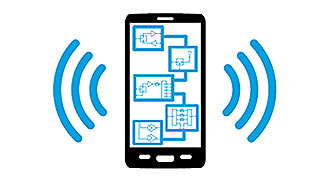Go Small or Go Home!
October 26, 2016
 To make it big, sometimes you have to make it small.
To make it big, sometimes you have to make it small.
Sound crazy? Maybe not.
The Nobel Prize in Chemistry was recently awarded to three scientists for developing the world's smallest machines. Black widow spiders are among the smallest yet most venomous animals on the planet. RF components, of course, are a great example, too. From power amplifiers and switches to filters and even complete RF front-ends, today's tiny RF components power global cellular networks, mobile devices and communication systems on land, sea and air.
Still don't believe small is mighty? Here's a list of a few tiny but mighty things:
- Teardrop trailers
- Ghost peppers
- Tiny houses
- Ant-Man
- Simone Biles
So, while everyone's working hard to make it big, there are plenty of us working on the next small thing.
The Shrinking RF Footprint in Smartphones
Small size matters for RF companies that want to be aligned with the smartphone market. While the "real estate" in today's smartphones and mobile devices has grown to accommodate larger screens and batteries, multiple cameras and other features, the space allocated for RF remains preciously Lilliputian.
The shrinking RF section must now accommodate more than ever, with the addition of many more cellular bands to support carrier aggregation and global coverage, Wi-Fi frequency bands supporting MIMO and multiple antennas to keep signals from getting crossed. After all, a cellphone that doesn't connect to a cell tower or a Wi-Fi router is called an MP3 player.
An RF front-end on today's smartphone has three important roles:
- Power amplification — Power amplifiers (PAs) interface with the antenna(s) to boost low power RF signals, connecting smartphones with cell towers.
- Cellular switching — Switches quickly and efficiently route frequency signals to maximize mobile data throughput.
- Filtering — Filters combine or separate frequency bands for strong connectivity (regional or global) without interference.
It's up to RF companies to incorporate these technologies into small form factors that meet the length, width and height restrictions of today's smartphones.
Thin is in. Even headphone jacks are disappearing in the name of sleeker phones. Though there's certainly a point of diminishing return on phone size and thickness — we've seen phones that bend and break — RF components must enable lighter and more elegant designs, without compromising performance.
Leading RF companies like Qorvo have answered the call for great things in small packages with marked success. Our RF Fusion™ portfolio combines all the necessary RF components into a single, high performance multi-chip module the size of a few grains of rice. This all-in-one chip contains core transmit and receive RF functionality, linking transceiver to antenna in one tiny but mighty placement. We've expanded the RF Fusion family significantly since its introduction two years ago, with many high volume wins in several marquee smartphones.
It's time the "small-minded" get their share of the spotlight. In today's RF scene, it's go small or go home!
This article first appeared in Brent's Musings on Microwave Journal.
Have another topic that you would like Qorvo experts to cover? Email your suggestions to the Qorvo Blog team and it could be featured in an upcoming post. Please include your contact information in the body of the email.
